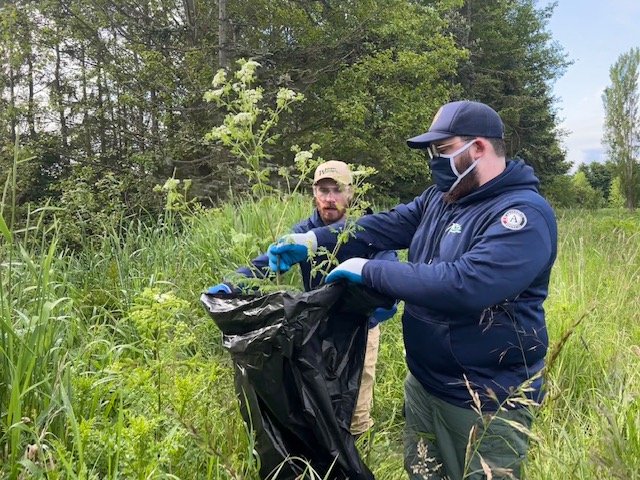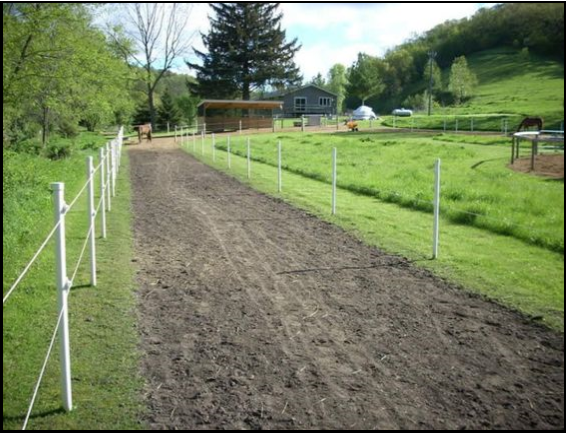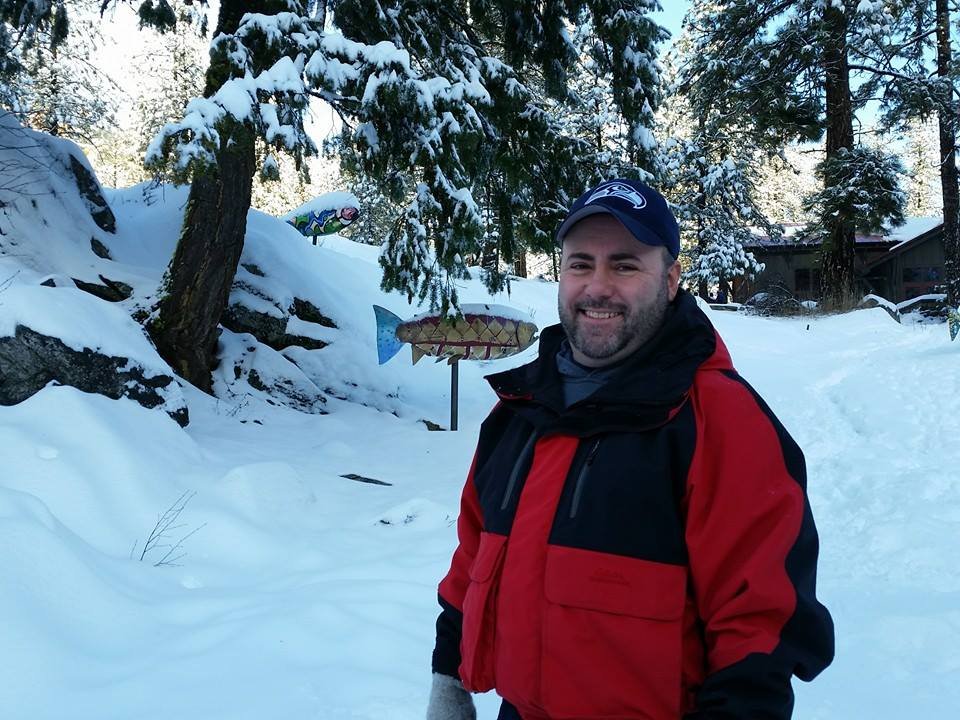Welcome Clallam Conservation
District Supervisor
Nicole Rasmussen
Nicole Rasmussen has been with Quileute Tribe as the Water Quality Biologist for the past 10 years. She graduated from Washington State University with a degree in Natural Resource Science with emphasis in fisheries. Nicole has a passion for salmon habitat restoration and protecting the resources for future generations. She has joined the Board of Supervisors to learn more about other areas of conservation and bring her background of knowledge to help Clallam Conservation District. Being a resident in Forks, Washington it will bring a west end perspective and input to the group. Between habitat restoration and Clean Water Act work, her goal is to make more fishable rivers for everyone to enjoy.
Washington Conservation Corps crew members bagging up poison hemlock along Matriotti Creek to keep it from going to seed.
Do you have a waterway on your property? Have you walked it lately to see what is growing there? The best way to control your invasive weeds is through Early Detection and Rapid Response.
Waterways such as rivers and streams are often forgotten areas on the land, but these areas can be some of the most important to pay a monthly visit to. Weed seeds can float downstream, or blow in on the wind, so keeping an eye out for potential invasive weeds in riparian areas is very important.
A few weeds to keep a close eye out for are knotweed, poison hemlock, Scotch broom, Himalayan blackberry, Herb Robert and reed canary grass. There are certainly many more weeds that can be found in riparian areas, but by walking your property frequently, especially during spring and summer months when weeds are more actively growing, you can establish a baseline of what weeds you have. This will help ensure that a weed doesn’t get out of control and begin to monoculture.
Now is the time to hand pull Herb Robert (before it flowers and sets seed) and Scotch Broom (when it is small)! Grab a garbage bag on your walk and fill it with these two weeds. The soils are easy to pull from after a rain and hand pulling can be an effective way to reduce some invasive weeds. Know your weed before you pull as pulling is not always an option. Pulling will stimulate some plants to grow faster, such as knotweed, or may be poisonous such a poison hemlock. Make sure to always wear your gloves.
If you have a stream or river on your property, and would like help with noxious weed infestations or restoring a riparian buffer, feel free to get in touch with us. Conservation District planners are available to provide free, on-site technical assistance. Depending on your situation, you may also be eligible for financial assistance to restore or enhance your riparian buffers. Contact us at 360-775-3747 ext. 5 or by email at info@clallamcd.org.
Clallam County Noxious Weeds Welcomes
New Coordinator
Welcome Christina St. John, the new Clallam County Noxious Weed Coordinator
The Clallam Conservation District works closely with The Clallam County Noxious Weed Board. We are excited to announce the new noxious weed Coordinator, Christina St. John, who is replacing Cathy Lucero, who has recently retired. Christina has been working in the fields of restoration and vegetation management for over 12 years, including working on revegetation of the Elwha River Restoration project. She has a master’s degree in Sustainable Forest Management from Oregon State University. Christina loves living on the Peninsula and spending time exploring the mountains and coast and supporting our wonderful local farms. Christina brings passion and enthusiasm to the Clallam County Noxious Weed Control Board, and is excited to continue the great work that they have been doing! Welcome Christina!
Track paddocks promote healthy pastures by providing a natural area for equines to live while pastures are re-growing after grazing.
A track paddock is a lane, usually around the perimeter of a pasture, designed to encourage equines to move and behave more naturally. Track paddocks can replace traditional horse-keeping facilities, like stalls and small pens and offer many benefits such as:
Healthier, strong hooves that require less trimming because of natural wear.
Alleviates boredom and the bad habits (cribbing, digging, chewing).
.Provides natural exercise, better conditioning, muscle tone, and weight control.
Healthier pastures since horses do not have constant access to pastures which can lead to overgrazing. Bare, manure-filled pastures are breeding grounds for parasites and runoff can pollute nearby streams and wells.
Tracks can double as riding areas and can be used as confinement area while pastures are resting.
Less weeds in pastures since track paddocks help facilitate proper stubble height of grass plants (3 – 4” minimum).
Track paddocks can be installed on both large and small properties by simply fencing a lane around the perimeter of a pasture or property. Even a small lane around a barn, turnout, or riding arena will promote movement, especially if water and feed are placed at opposite ends. Check out our Track Paddocks publication for tips on building a track paddock on your farm. Have you already installed a track paddock? If so PLEASE tell us all about it in the comment section. Thank you!
New Livestock Specialist
Dan McCarty has recently joined WSU’s Small Farms Team as a Livestock Specialist and is available to provide technical assistance to livestock producers in Clallam County
Dan McCarty was recently hired as a Livestock Specialist with Washington State University’s Small Farms Team. Dan brings extensive experience on a variety of livestock management systems to Clallam County and is available to make one-on-one site consultations to help livestock producers address resource needs. Dan grew up on a farm and has first-hand experience raising irrigated alfalfa, cattle, sheep, horses, hogs, and working dogs. He was also active in FFA and 4-H and earned a Bachelor of Science Degree in Agricultural Science from University of Idaho. His previous positions include working with conservation districts and state agriculture departments in both Idaho and Washington where he helped farmers and livestock producers with a variety of needs including conservation practices. Please join us in welcoming Dan to Clallam County! He can be reached by calling 360-460-6683 or emailing dan.mccarty@wsu.edu.
Follow Us on Facebook
FOLLOW US on Facebook for articles and links to educational material and upcoming events.
CONSERVATION SPONSORS
Peninsula Environmental Group - (360) 819-3081 www.peninsulaenvironmental.com
Clark Horticultural Inc - (360) 460-9178 www.ClarkHorticultural.com
Eagle Creek Tractor - (360) 683-9391
John and Kriss Seago
Conservation News sponsorship's cost $50/yr for business names printed every issue or $100/yr for a name every issue and a business card once a year. They help offset publishing and distributing costs to reach nearly 4,000 readers. CALL US TO FEATURE YOUR NAME!







